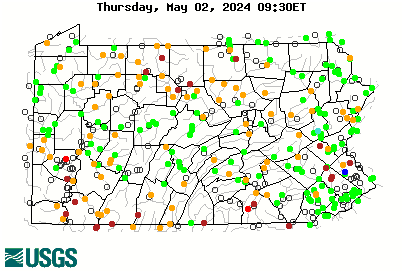- Joined
- May 3, 2011
- Messages
- 6,651
Been messing around with the new PGC mapping features. There is a pretty neat draw/measure feature that allows you to VERY accurately estimate hiking distances into/out of streams. You can also trace the perimeter of a stream's watershed and calculate its square mileage. I find this is useful in determining whether a watershed is large enough to produce a stream worth exploring. This feature is VERY easy to use...In just messing around I traced the watershed based on the topo features of a watershed of known size (about 5 sq miles) and I came within 0.07 of a sq mile of the published figure for that watershed. Pretty cool.
Obviously there are other factors at play like gradient, the amount and type of spring sources, etc, but in general, for small streams, I find the following:
About 1.5-2 square miles is the minimum to produce a year round
stream of the minimum fishable size. This will still be tiny, you can easily step across it.
2-5 square miles will produce a stream that is still very small, but will start to have enough water to make some consistently decent habitat. It might take a big step, or one step in the stream to get across these.
5-10 square miles produces a nice sized, very fishable small stream. These are generally the ones that I seek out and are my favorite to fish. The best balance of small stream intimacy and plenty of water.
10-20 square miles and you have a good sized stream. Some of these can be very good, but some start to get too big and run into thermal issues at this size if they're not well forested.
Somewhere around 20 square miles usually you are approaching the border of what I'd call a "big" small stream and a "small" medium stream.
Anyone else use these kinds of features, thoughts?
Obviously there are other factors at play like gradient, the amount and type of spring sources, etc, but in general, for small streams, I find the following:
About 1.5-2 square miles is the minimum to produce a year round
stream of the minimum fishable size. This will still be tiny, you can easily step across it.
2-5 square miles will produce a stream that is still very small, but will start to have enough water to make some consistently decent habitat. It might take a big step, or one step in the stream to get across these.
5-10 square miles produces a nice sized, very fishable small stream. These are generally the ones that I seek out and are my favorite to fish. The best balance of small stream intimacy and plenty of water.
10-20 square miles and you have a good sized stream. Some of these can be very good, but some start to get too big and run into thermal issues at this size if they're not well forested.
Somewhere around 20 square miles usually you are approaching the border of what I'd call a "big" small stream and a "small" medium stream.
Anyone else use these kinds of features, thoughts?




